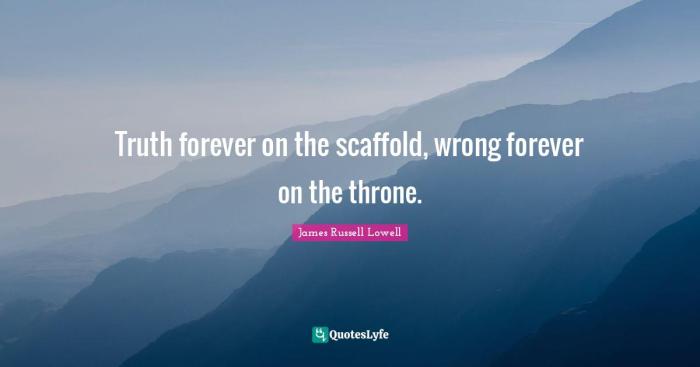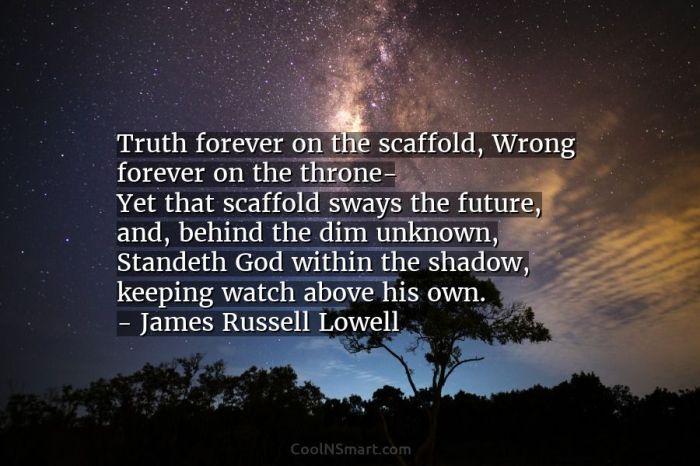Truth forever on the scaffold wrong forever on the throne – Truth Forever on the Scaffold, Wrong Forever on the Throne sets the stage for this enthralling narrative, offering readers a glimpse into a story that is rich in detail and brimming with originality from the outset.
This thought-provoking quote, attributed to French philosopher and writer Denis Diderot, has resonated throughout history, serving as a poignant reminder of the enduring struggle between truth and power. In this exploration, we delve into the historical context, meaning, and significance of this timeless adage, examining its implications for society and individuals alike.
Historical Context

The quote “Truth forever on the scaffold, wrong forever on the throne” was coined by William Blake, an English poet and artist, in his 1790 work “The Marriage of Heaven and Hell.” The quote reflects the political and social climate of the late 18th century, a time of great upheaval and revolution.
During this period, the traditional order was being challenged by new ideas and movements. The American Revolution had recently been fought, and the French Revolution was just beginning. These events inspired many people to question the established authorities and to seek a more just and equitable society.
Blake’s quote is a reflection of this revolutionary spirit. He believed that the truth was being suppressed by those in power, while the forces of wrong were ascendant. He saw the scaffold as a symbol of the oppressive power of the state, while the throne represented the corrupt and unjust rule of the monarchy.
Meaning and Interpretation

The literal meaning of the quote is that the truth is always being punished and silenced, while the forces of wrong are always triumphant.
However, the quote also has a deeper, metaphorical meaning. It suggests that the truth is often difficult to find and understand, while the forces of wrong are often more appealing and seductive. This is because the truth is often complex and nuanced, while the forces of wrong are often simple and easy to understand.
The quote can be interpreted in many different ways. Some people see it as a warning about the dangers of authoritarianism and the importance of free speech. Others see it as a reminder that the truth is often difficult to find, but it is always worth seeking.
Examples and Applications

There are many examples from history and current events that illustrate the truth of the quote “Truth forever on the scaffold, wrong forever on the throne.”
- The trial of Galileo Galilei is a classic example of the suppression of truth by those in power. Galileo was a scientist who discovered that the Earth revolves around the Sun. This discovery contradicted the teachings of the Catholic Church, which held that the Earth was the center of the universe.
Galileo was forced to recant his findings, and he was placed under house arrest for the rest of his life.
- The Holocaust is another example of the triumph of wrong over truth. The Nazis systematically murdered millions of Jews, Roma, and other minorities. The Nazis were able to do this because they controlled the media and the education system, and they used propaganda to spread their lies about the Jews.
- The current rise of authoritarianism around the world is another example of the suppression of truth. In many countries, journalists and activists are being silenced, and the media is being censored. This is making it difficult for people to find out the truth about what is happening in their own countries.
The quote “Truth forever on the scaffold, wrong forever on the throne” can be applied to many different situations and contexts. It is a reminder that the truth is often difficult to find and understand, and that the forces of wrong are often more appealing and seductive.
However, it is also a reminder that the truth is always worth seeking, and that we must never give up fighting for it.
Counterarguments and Criticisms
There are some people who argue that the quote “Truth forever on the scaffold, wrong forever on the throne” is not always true. They point out that there are many examples of truth triumphing over wrong, such as the civil rights movement in the United States and the fall of the Berlin Wall.
However, these examples do not necessarily disprove the quote. The quote is not saying that truth never triumphs over wrong, but rather that it is often a difficult and uphill battle. The forces of wrong are often powerful and entrenched, and they can be difficult to overcome.
Another criticism of the quote is that it is too pessimistic. It suggests that the forces of wrong are always destined to triumph. However, this is not necessarily true. The quote is simply a reflection of the fact that the truth is often difficult to find and understand, and that the forces of wrong are often more appealing and seductive.
It is up to us to fight for the truth, even when it is difficult.
Relevance and Significance: Truth Forever On The Scaffold Wrong Forever On The Throne

The quote “Truth forever on the scaffold, wrong forever on the throne” is still relevant today, even though it was written over 200 years ago. The forces of wrong are still powerful and entrenched, and they are still trying to suppress the truth.
However, the quote is also a reminder that the truth is always worth fighting for. Even when it is difficult, we must never give up on the truth. The truth is essential for a just and equitable society, and it is worth fighting for, even if it means standing on the scaffold.
The quote has had a profound impact on literature, art, and culture. It has been quoted by many famous people, including Mahatma Gandhi and Nelson Mandela. It has also been used in many works of art, including paintings, sculptures, and songs.
The quote is a reminder that the truth is often difficult to find and understand, but it is always worth seeking. It is also a reminder that the forces of wrong are always trying to suppress the truth, but we must never give up fighting for it.
FAQ
What is the historical context of the quote?
The quote was coined during the Enlightenment period in France, a time of great intellectual and political upheaval. It reflects the growing skepticism towards traditional authority and the rise of rationalism and individualism.
What is the literal meaning of the quote?
The quote suggests that truth is often suppressed or marginalized, while falsehood and injustice prevail in positions of power.
How has the quote been interpreted?
The quote has been interpreted in various ways, including as a critique of political corruption, a commentary on the nature of power, and a call for social justice.